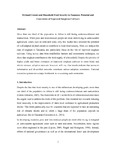Dryland cereals and Household Food Security in Tanzania: Potential and Constraints of Improved Sorghum Cultivars

View/
Date
2011Author
Schipmann-Schwarze, C.
Muange, Elijah
Orr, Alastair
Mafuru, January M.
Metadata
Show full item recordAbstract
More than one third of the population in Africa is still facing undernourishment and
malnutrition. While poor and food-insecure people are most often living in unfavourable
agricultural zones, such as semi-arid areas, only few studies have assessed the potential
of well adapted dryland cereals to contribute to local food security. Here, we analyze the
case of sorghum in Tanzania, and particularly focus on the role of improved sorghum
cultivars. Using survey data from smallholder farmers and econometric techniques, we
show that sorghum contributes to the food supply of a household. Despite the promise of
higher yields and better resistance of improved sorghum cultivars to some biotic and
abiotic stresses, adoption rates are, however, still low. Our results indicate that access to
information and diversified networks constitute serious adoption constraints. National
extension systems are a major bottleneck in overcoming such constraints.
